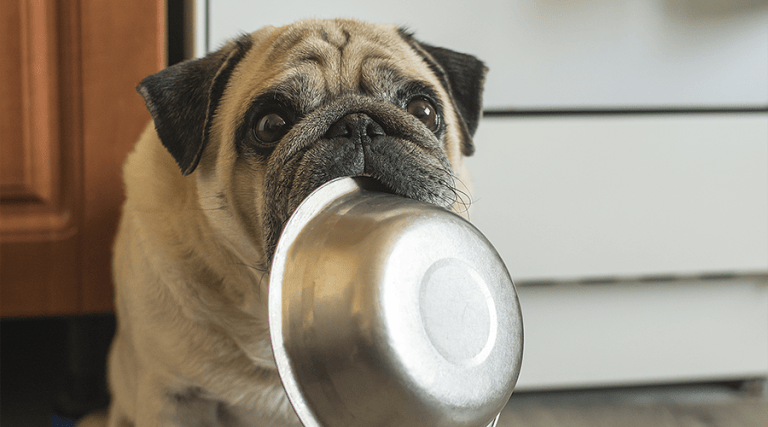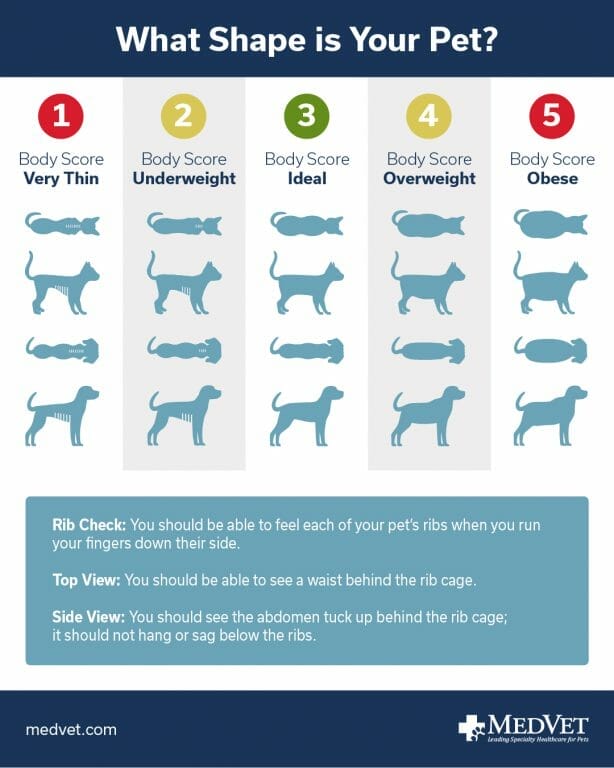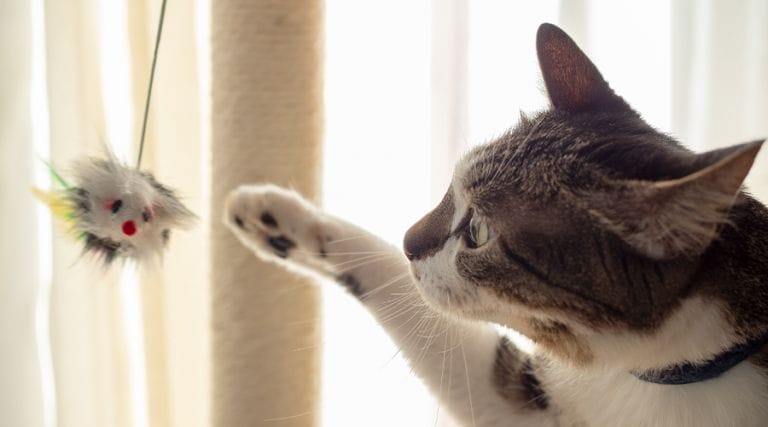Integrative Medicine, Rehabilitation
Help Your Pet Peel off Pounds and Reach a Healthy Weight

Did you know your pet might benefit from weight loss? According to the Association for Pet Obesity Prevention, around 54% of dogs and 60% of cats are overweight. Being overweight can significantly impact their health and longevity.
Dangers for overweight pets
Obesity in pets creates many potential issues, beginning with quality-of-life. Overweight pets may tire quickly when participating in activities they enjoy. The strain of excess fat on their bodies can lead to bigger issues, too.
Overweight pets are at a greater risk for developing conditions like osteoarthritis, orthopedic conditions, diabetes, high blood pressure, kidney, heart and respiratory diseases, and more. Pets carrying extra pounds also have a shorter life expectancy; it can take as much as 2.5 years off your pet’s life.
How to tell if your pet is overweight
When considering your pet’s weight, it is not all about pounds. For animals, we consider overall body condition and percentage of body fat to tell us if an animal is overweight.
There are three things you can do to visually evaluate your pet:
- Rib check – You should be able to feel each of your pet’s ribs when you run your fingers down their side.
- Top view – When you view your pet from the top, you should be able to see a waist behind the rib cage.
- Side view – When you view your pet from the side, you should see the abdomen tuck up behind the rib cage. The abdomen should not hang or sag below the ribs.

Helping your pet lose weight
Fortunately, being overweight is a condition that can be treated. Slow and steady is the key to healthy weight loss for your pet. Losing weight too quickly by drastically cutting back on your pet’s food can cause extra strain on the body. Your pet’s age and health may affect weight loss recommendations, but in general, pets should lose no more than 0.5-2% body weight per week.
Just like for humans, it’s about balancing calorie intake with activity levels. What goes in your pet’s bowl is just as important as the amount of exercise they get.
Food:
Consideration of diet and daily calorie intake will be at the top of the list.
- Talk with your veterinarian to find out the caloric needs for your pet considering their age, body condition and health status. They will consider the specific nutrients your pet needs to lose weight and the calories needed to support their overall health. Then be sure to read food labels to find the correct amount of the brand you are using.
- Use a measuring cup and don’t eyeball or guess at an amount. Remember that if you switch foods, you may need to also adjust the amount you’re feeding. The calorie content of one cup of brand A is not the same as one cup of brand B.
- Steer clear of automatic feeders that continuously refill your pet’s bowl. That’s like giving your pet a key to an unlimited buffet.
- Remember: treats count in the total! All those extras can add up. If your veterinarian permits, leave some room in your pet’s diet for special treats and be sure you’re reading labels as well; some treats are healthier than others. You can also work to find other things besides food to reward your pet for good behavior like extra play time with a favorite toy or extra belly rubs.
- Don’t let your pet take you on a guilt trip. If Fido lays by his bowl sighing, but you know he’s already been fed, stay strong! And make sure you ignore those big eyes begging for the rest of your burger. Try redirecting his attention to another activity.
- Take a pass on sharing table scraps. Certain foods can be hard on your pet’s weight and sometimes hazardous since people food is not all pet friendly. For example, a piece of cheese can easily be the caloric equivalent of a whole meal for a dog or cat. Your veterinarian can make recommendations for healthy alternatives, but some ideas include green beans, carrots, ice cubes, whole grain cereal, and plain rice cakes.

Exercise:
It’s also time to get your pet moving. Consistent, daily activity is key.
- Start with small walks and work up to longer ones. Consult with your veterinarian to determine the best exercise plan for your pet’s starting weight and health. Set a goal to take walks for exercise, not sniffing and strolling. An exercise walk is not the time to stop and smell the flowers. Start your walk at a steady pace that your pet can tolerate. On your way back home, you can let them explore and sniff.
- Play a game of fetch or find a toy your pet enjoys. Cats especially don’t need long amounts of exercise but can benefit from short bursts of activity. Tap into the predator instinct in your cat by offering different types of toys. Be sure to mix it up. Something that is interesting today could be old news tomorrow.
- Keep them guessing. Creative ideas such as searching for small, low calorie treats, or toys that dispense part of their meal can help get some extra steps in.
- Consider working with a rehabilitation specialist. A specialist can help develop an individualized plan for pets who have a significant amount of weight to lose, or underlying health conditions like joint or spinal pain.

If you think your pet needs to shed some pounds, be sure to talk with your family veterinarian about setting an appropriate weight loss plan for your pet. A Certified Rehabilitation Therapist or practitioner could be useful in developing a more specialized plan of action based on of your pet’s needs. Consulting with your family veterinarian or a specialist can also help rule out any underlying medical conditions that could be causing weight gain.
With support from your veterinary team, careful feedings, and consistent exercise, your pet can slim down to their recommended weight and decrease the risks to their health and wellbeing.